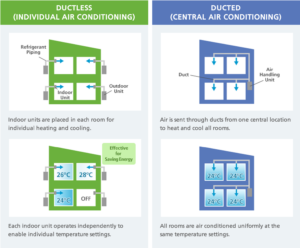A non-ductable AC, often referred to as a non-ducted or ductless AC, is a type of air conditioning system that does not use ductwork to distribute cooled air throughout a building. Instead, it directly delivers air to the specific zones or rooms where cooling is required. Here are the key details about non-ductable ACs:
Types of Non-Ductable ACs
- Split ACs: This is the most common type, consisting of an indoor unit that delivers cooled air and an outdoor unit that houses the compressor and condenser. These units connect by refrigerant piping and electrical wiring.
- Window ACs: These are single-unit systems where the entire AC is mounted in a window or a wall opening. It is a compact and self-contained unit.
- Portable ACs: These are movable units that can be placed anywhere in a room and require only an exhaust hose to vent hot air outside.
Components and Features
- Indoor Unit: Contains the evaporator coil and a fan to circulate cool air into the room. It mounts on the wall or ceiling.
- Outdoor Unit: Houses the compressor, condenser coil, and expansion valve. It places outside the building.
- Refrigerant Piping: Connects the indoor and outdoor units, carrying refrigerant between them.
- Remote Control: Most units come with a remote for easy control of temperature settings, fan speed, and operational modes.
- Air Filters: Non-ductable ACs typically include filters to remove dust, allergens, and other particles from the air.
Advantages
- Energy Efficiency: Ductless systems are often more energy-efficient as they avoid the energy losses associated with ductwork in traditional HVAC systems.
- Zoning Flexibility: They allow for individual room temperature control, which can lead to energy savings by cooling only occupied spaces.
- Easy Installation: These systems are generally easier and less invasive to install compared to ducted systems.
- Compact Design: They save space and are suitable for areas where ductwork installation is impractical.
Disadvantages
- Initial Cost: The upfront cost of ductless systems can be higher compared to some ducted systems.
- Aesthetic Impact: The indoor units can be more visible and may affect room aesthetics.
- Maintenance: Requires regular maintenance of filters and coils to ensure efficient operation.
Applications
- Residential: Commonly used in homes, especially in retrofitting older buildings without existing ductwork.
- Commercial: Used in offices, small commercial spaces, and buildings where specific zoning is necessary.
- Institutional: Suitable for schools, hospitals, and other institutions where maintaining different temperatures in various rooms is crucial.
Popular Brands and Models
- Mitsubishi Electric: Known for its energy-efficient and reliable ductless systems.
- Daikin: Offers a range of ductless solutions with advanced features like smart control.
- LG: Provides stylish and powerful ductless AC units suitable for various applications.
In summary, non-ductable ACs offer a versatile and energy-efficient cooling solution, ideal for both residential and commercial applications where traditional ductwork is either impractical or undesired. They provide significant advantages in terms of zoning flexibility, installation ease, and energy savings. However, potential buyers should consider the higher initial costs and regular maintenance needs.

Looking to install a commercial HVAC System or Duct work in your Business Area?
Contact Vipul Ac to learn about our HVAC Service
Call +91 8000092000 Today.
